The charged currents in the outer conducting regions of the earth's core are thought to be responsible for earth's magnetism. What might be the 'battery' (i.e., the source of energy) to sustain these currents ?
One possibility is the radioactivity in the interior of the earth. But nobody really knows the real source of energy.
Topper's Solved these Questions
- MAGNETISM AND MATTERBOOK - U-LIKE SERIESCHAPTER - MAGNETISM AND MATTEREXERCISE - ADDITIONAL EXERCISES
19 Videos
- MAGNETISM AND MATTERBOOK - U-LIKE SERIESCHAPTER - MAGNETISM AND MATTEREXERCISE - CASE BASED/SOURCE-BASED INTEGRATED QUESTIONS
8 Videos
- EXAMINATION PAPER 2020 (SOLVED)BOOK - U-LIKE SERIESCHAPTER - EXAMINATION PAPER 2020 (SOLVED)EXERCISE - SECTION D
6 Videos
- MODEL TEST PAPER 1 (UNSOLVED)BOOK - U-LIKE SERIESCHAPTER - MODEL TEST PAPER 1 (UNSOLVED)EXERCISE - SECTION B
1 Videos
Similar Questions
Answer the following questions: (a) The earth's magnetic field varies from point to point in space.
Does is also change with time? If so, on what time scale does it change appreciably?
(b) The earth's core is known to contain iron. Yet geologists do not regard this as a source of earth's magnetism, why?
(c) The charged currents in the outer conducting regions of earth's core are thought to be possible for earth's magnetism. What might be the battery to sustain these currents?
(d) The earth may have even reversed the direction of its field several times during its history of 4 to 5 billion years. How can geologist know about the earth's field in such distant past?
(e) The earth's field departs from its dipole shape substantially at large distances (greater than about 30000km). What agencies may be responsible for this distortion?
(f) Interstellar space has an extremely weak magnetic field of the order of 10−12T. Can such a weak field be of any significant consequence? Explain.
View SolutionRead the following text and answer the following questions on the basis of the same:
If we move into space and study the Earth's invisible magnetic field, it wouldn't really look like a bar magnet at all. Earth's magnetic field gets stretched out into a comet-like shape with a tail of magnetism that stretches millions of miles behind the earth, opposite to the Sun. The Sun has a wind of gas that pushes the earths field from the left to the right in the picture.

The core of the Earth is an electromagnet. Although the crust is solid, the core of the Earth is surrounded by a mixture of molten iron and nickle. The magnetic field of Earth is caused by currents of electricity that flow in the molten core. These currents are hundreds of miles wide and flow at thousands of miles per hour as the Earth rotates. The powerful magnetic field passes out through the core of the Earth, passes through the crust and enters space. This picture shows the solid inner core region (inner circle) surrounded by a molten outer core (the area between the two circles). The currents flow in the outer core, travel outwards through the rest of the earth's interior. If the Earth rotated faster, it would have a stronger magnetic field.

By the time the field has reached the surface of Earth, it has weakened a lot, but it is still strong enough to keep your compass needles pointed towards one of its poles. All magnets have two poles: a North Pole and a South Pole. The magnetic poles of earth are not fixed on the surface, but wander quite a bit. The pole in the Northern Hemisphere seems to be moving northwards in geographic latitude by about 10 kilometres per year by an average.
Earth's magnetic field has a:
View Solution
Knowledge Check
Read the following text and answer the following questions on the basis of the same:
If we move into space and study the Earth's invisible magnetic field, it wouldn't really look like a bar magnet at all. Earth's magnetic field gets stretched out into a comet-like shape with a tail of magnetism that stretches millions of miles behind the earth, opposite to the Sun. The Sun has a wind of gas that pushes the earths field from the left to the right in the picture.
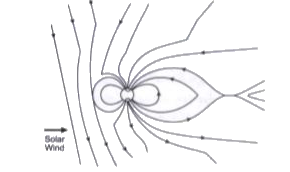
The core of the Earth is an electromagnet. Although the crust is solid, the core of the Earth is surrounded by a mixture of molten iron and nickle. The magnetic field of Earth is caused by currents of electricity that flow in the molten core. These currents are hundreds of miles wide and flow at thousands of miles per hour as the Earth rotates. The powerful magnetic field passes out through the core of the Earth, passes through the crust and enters space. This picture shows the solid inner core region (inner circle) surrounded by a molten outer core (the area between the two circles). The currents flow in the outer core, travel outwards through the rest of the earth's interior. If the Earth rotated faster, it would have a stronger magnetic field.
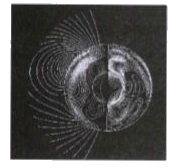
By the time the field has reached the surface of Earth, it has weakened a lot, but it is still strong enough to keep your compass needles pointed towards one of its poles. All magnets have two poles: a North Pole and a South Pole. The magnetic poles of earth are not fixed on the surface, but wander quite a bit. The pole in the Northern Hemisphere seems to be moving northwards in geographic latitude by about 10 kilometres per year by an average.
The Earth's magnetism is due to:Ainduction of Sun's magnetism.Bcurrent produced by the movement of molten metals.Csea current.Drevolution of the Earth round the Sun.Read the following text and answer the following questions on the basis of the same:
If we move into space and study the Earth's invisible magnetic field, it wouldn't really look like a bar magnet at all. Earth's magnetic field gets stretched out into a comet-like shape with a tail of magnetism that stretches millions of miles behind the earth, opposite to the Sun. The Sun has a wind of gas that pushes the earths field from the left to the right in the picture.
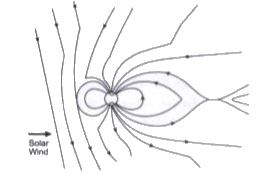
The core of the Earth is an electromagnet. Although the crust is solid, the core of the Earth is surrounded by a mixture of molten iron and nickle. The magnetic field of Earth is caused by currents of electricity that flow in the molten core. These currents are hundreds of miles wide and flow at thousands of miles per hour as the Earth rotates. The powerful magnetic field passes out through the core of the Earth, passes through the crust and enters space. This picture shows the solid inner core region (inner circle) surrounded by a molten outer core (the area between the two circles). The currents flow in the outer core, travel outwards through the rest of the earth's interior. If the Earth rotated faster, it would have a stronger magnetic field.
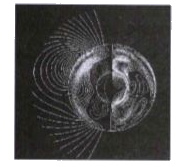
By the time the field has reached the surface of Earth, it has weakened a lot, but it is still strong enough to keep your compass needles pointed towards one of its poles. All magnets have two poles: a North Pole and a South Pole. The magnetic poles of earth are not fixed on the surface, but wander quite a bit. The pole in the Northern Hemisphere seems to be moving northwards in geographic latitude by about 10 kilometres per year by an average.
Earth's magnetic field may increase if:Ait rotates on its axis faster.Bits direction of rotation is changed.Cit revolves round the Sun faster.DAll of the aboveRead the following text and answer the following questions on the basis of the same:
If we move into space and study the Earth's invisible magnetic field, it wouldn't really look like a bar magnet at all. Earth's magnetic field gets stretched out into a comet-like shape with a tail of magnetism that stretches millions of miles behind the earth, opposite to the Sun. The Sun has a wind of gas that pushes the earths field from the left to the right in the picture.
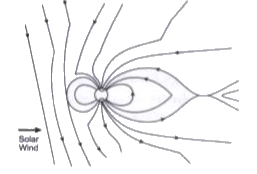
The core of the Earth is an electromagnet. Although the crust is solid, the core of the Earth is surrounded by a mixture of molten iron and nickle. The magnetic field of Earth is caused by currents of electricity that flow in the molten core. These currents are hundreds of miles wide and flow at thousands of miles per hour as the Earth rotates. The powerful magnetic field passes out through the core of the Earth, passes through the crust and enters space. This picture shows the solid inner core region (inner circle) surrounded by a molten outer core (the area between the two circles). The currents flow in the outer core, travel outwards through the rest of the earth's interior. If the Earth rotated faster, it would have a stronger magnetic field.

By the time the field has reached the surface of Earth, it has weakened a lot, but it is still strong enough to keep your compass needles pointed towards one of its poles. All magnets have two poles: a North Pole and a South Pole. The magnetic poles of earth are not fixed on the surface, but wander quite a bit. The pole in the Northern Hemisphere seems to be moving northwards in geographic latitude by about 10 kilometres per year by an average.
The magnetic poles of Earth are:Afixed on the surfaceBwander throughout the Earth's surfaceCwander about 1000 kilometres per year on an average.Dwander about 10 kilometres per year on an average.
The graph given here represents an idealized sinusoidal current flow between a cloud at a height of 1 km and the earth, during a lightning discharge. Value of I0 is 157 kA and T = 0.2 ms. Assume that discharge happens when the electric field in the air between the cloud and the earth becomes equal to the breakdown field of air i.e., E0=3×106V/m
(a) Calculate the total charge flow due to lightning.
(b) Calculate the average current between the cloud and the earth during the lightning.
(c) Assume that the entire charge on the cloud is released during the lightning and estimate the capacitance of the cloud – Earth system.
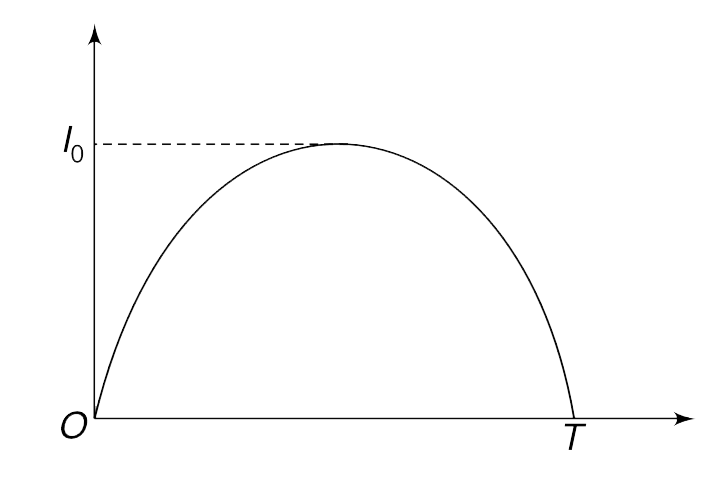
View SolutionRead the following text and answer the following questions on the basis of the same:
Earth's magnetism: Earth's magnetic field is caused by a dynamo effect. The effect works in the same way as a dynamo light on a bicycle. Magnets in the dynamo start spinning when the bicycle is pedaled, creating an electric current. The electricity is then used to turn on the light. This process also works in reverse. If you have a rotating electric current, it will create a magnetic field. On Earth, flowing of liquid metal in the outer core of the planet generates electric currents. The rotation of Earth on its axis causes these electric currents to form a magnetic field which extends around the planet. The average magnetic field strength in the Earth's outer core was measured to be 25 Gauss, 50 times stronger than the magnetic field at the surface. The magnetic field is extremely important for sustaining life on Earth. Without it, we would be exposed to high amounts of radiation from the
Earth's outer core was measured to be 25 Gauss, 50 times stronger than the magnetic field at the surface. The magnetic field is extremely important for sustaining life on Earth. Without it, we would be exposed to high amounts of radiation from the Sun and our atmosphere would be free to leak into space. This is likely what happened to the atmosphere on Mars. As Mars doesn't have flowing liquid metal in its core, it doesn't produce the same dynamo effect. This left the planet with a very weak magnetic field, allowing for its atmosphere to be stripped away by solar winds, leaving it uninhabitable. Based upon the study of lava flows throughout the world, it has been proposed that the Earth's magnetic field reverses at an average interval of approximately 300,000 years. However, the last such event occurred some 780,000 years ago.
Average magnetic field strength in the Earth's outer core is:
View SolutionRead the following text and answer the following questions on the basis of the same:
Earth's magnetism: Earth's magnetic field is caused by a dynamo effect. The effect works in the same way as a dynamo light on a bicycle. Magnets in the dynamo start spinning when the bicycle is pedaled, creating an electric current. The electricity is then used to turn on the light. This process also works in reverse. If you have a rotating electric current, it will create a magnetic field. On Earth, flowing of liquid metal in the outer core of the planet generates electric currents. The rotation of Earth on its axis causes these electric currents to form a magnetic field which extends around the planet. The average magnetic field strength in the Earth's outer core was measured to be 25 Gauss, 50 times stronger than the magnetic field at the surface. The magnetic field is extremely important for sustaining life on Earth. Without it, we would be exposed to high amounts of radiation from the
Earth's outer core was measured to be 25 Gauss, 50 times stronger than the magnetic field at the surface. The magnetic field is extremely important for sustaining life on Earth. Without it, we would be exposed to high amounts of radiation from the Sun and our atmosphere would be free to leak into space. This is likely what happened to the atmosphere on Mars. As Mars doesn't have flowing liquid metal in its core, it doesn't produce the same dynamo effect. This left the planet with a very weak magnetic field, allowing for its atmosphere to be stripped away by solar winds, leaving it uninhabitable. Based upon the study of lava flows throughout the world, it has been proposed that the Earth's magnetic field reverses at an average interval of approximately 300,000 years. However, the last such event occurred some 780,000 years ago
Electric current in the Earth's body is generated due to:
View SolutionRead the following text and answer the following questions on the basis of the same:
Earth's magnetism: Earth's magnetic field is caused by a dynamo effect. The effect works in the same way as a dynamo light on a bicycle. Magnets in the dynamo start spinning when the bicycle is pedaled, creating an electric current. The electricity is then used to turn on the light. This process also works in reverse. If you have a rotating electric current, it will create a magnetic field. On Earth, flowing of liquid metal in the outer core of the planet generates electric currents. The rotation of Earth on its axis causes these electric currents to form a magnetic field which extends around the planet. The average magnetic field strength in the Earth's outer core was measured to be 25 Gauss, 50 times stronger than the magnetic field at the surface. The magnetic field is extremely important for sustaining life on Earth. Without it, we would be exposed to high amounts of radiation from the
Earth's outer core was measured to be 25 Gauss, 50 times stronger than the magnetic field at the surface. The magnetic field is extremely important for sustaining life on Earth. Without it, we would be exposed to high amounts of radiation from the Sun and our atmosphere would be free to leak into space. This is likely what happened to the atmosphere on Mars. As Mars doesn't have flowing liquid metal in its core, it doesn't produce the same dynamo effect. This left the planet with a very weak magnetic field, allowing for its atmosphere to be stripped away by solar winds, leaving it uninhabitable. Based upon the study of lava flows throughout the world, it has been proposed that the Earth's magnetic field reverses at an average interval of approximately 300,000 years. However, the last such event occurred some 780,000 years ago.
Which of the followings is the reason for Earth's magnetism? Which planet has no own magnetic field ?
View SolutionRead the following text and answer the following questions on the basis of the same:
Earth's magnetism: Earth's magnetic field is caused by a dynamo effect. The effect works in the same way as a dynamo light on a bicycle. Magnets in the dynamo start spinning when the bicycle is pedaled, creating an electric current. The electricity is then used to turn on the light. This process also works in reverse. If you have a rotating electric current, it will create a magnetic field. On Earth, flowing of liquid metal in the outer core of the planet generates electric currents. The rotation of Earth on its axis causes these electric currents to form a magnetic field which extends around the planet. The average magnetic field strength in the Earth's outer core was measured to be 25 Gauss, 50 times stronger than the magnetic field at the surface. The magnetic field is extremely important for sustaining life on Earth. Without it, we would be exposed to high amounts of radiation from the
Earth's outer core was measured to be 25 Gauss, 50 times stronger than the magnetic field at the surface. The magnetic field is extremely important for sustaining life on Earth. Without it, we would be exposed to high amounts of radiation from the Sun and our atmosphere would be free to leak into space. This is likely what happened to the atmosphere on Mars. As Mars doesn't have flowing liquid metal in its core, it doesn't produce the same dynamo effect. This left the planet with a very weak magnetic field, allowing for its atmosphere to be stripped away by solar winds, leaving it uninhabitable. Based upon the study of lava flows throughout the world, it has been proposed that the Earth's magnetic field reverses at an average interval of approximately 300,000 years. However, the last such event occurred some 780,000 years ago.
Which of the followings is the reason for Earth's magnetism?
View Solution
